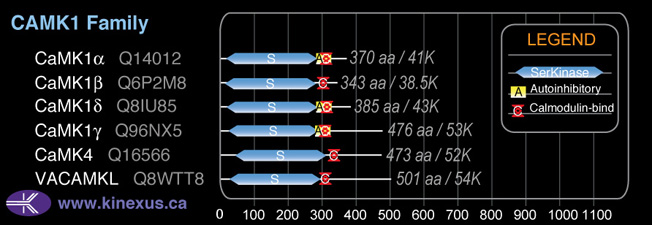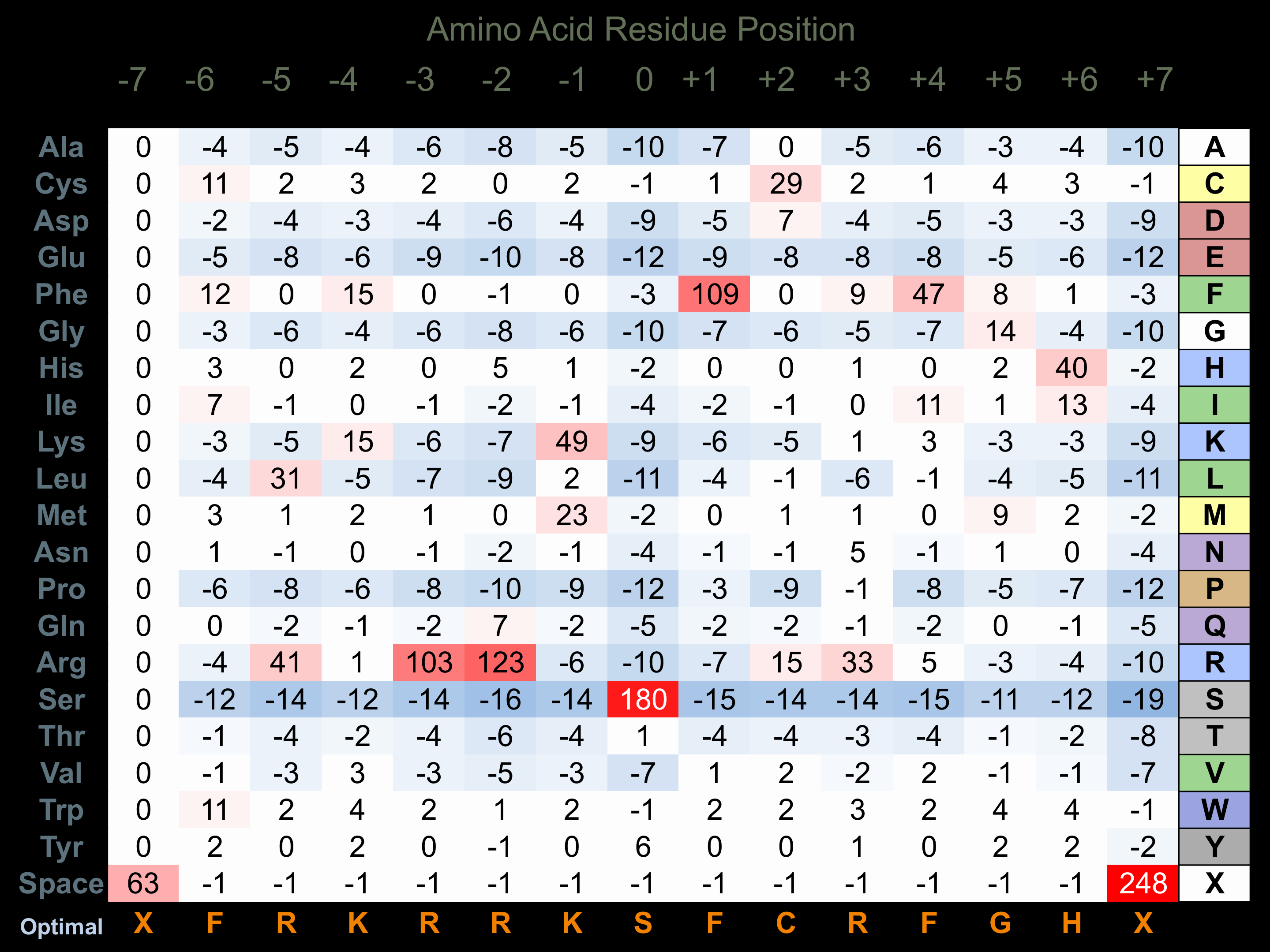Nomenclature
Short Name:
CaMK1g
Full Name:
Calcium/calmodulin-dependent protein kinase type I gamma
Alias:
- Calcium/calmodulin-dependent protein kinase I gamma
- Calcium/calmodulin-dependent protein kinase IG
- EC 2.7.11.17
- KCC1G
- Kinase CaMK1-gamma
- VWS1
- CaMK1-gamma
- CaMK-like CREB kinase III
- CLICK III
- CLICKIII
Classification
Type:
Protein-serine/threonine kinase
Group:
CAMK
Family:
CAMK1
SubFamily:
NA
Structure
Mol. Mass (Da):
53,087
# Amino Acids:
476
# mRNA Isoforms:
2
mRNA Isoforms:
53,087 Da (476 AA; Q96NX5); 51,486 Da (460 AA; Q96NX5-2)
4D Structure:
NA
1D Structure:
3D Image (rendered using PV Viewer):
PDB ID
Subfamily Alignment

Domain Distribution:
| Start | End | Domain |
|---|---|---|
| 23 | 277 | Pkinase |
| 277 | 317 | Autoinhibitory |
| 297 | 318 | CaM_binding |
Kinexus Products
Click on entries below for direct links to relevant products from Kinexus for this protein kinase.
hiddentext
Post-translation Modifications
For detailed information on phosphorylation of this kinase go to PhosphoNET
Acetylated:
K56, K73.
Serine phosphorylated:
S168.
Tyrosine phosphorylated:
Y185-.
Distribution
Based on gene microarray analysis from the NCBI
Human Tissue Distribution
% Max Expression:
Mean Expression:
Number of Samples:
Standard Deviation:
% Max Expression:
Mean Expression:
Number of Samples:
Standard Deviation:
 16
16
433
29
670
 1.2
1.2
33
15
42
 2
2
46
12
59
 16
16
443
88
511
 10
10
273
24
219
 0.4
0.4
11
74
11
 7
7
187
31
469
 16
16
434
38
593
 10
10
269
17
235
 3
3
85
73
142
 2
2
46
32
61
 24
24
661
152
639
 1.2
1.2
33
35
37
 2
2
57
12
66
 1.1
1.1
29
25
43
 0.7
0.7
20
14
21
 1.3
1.3
35
120
52
 2
2
47
22
71
 2
2
47
88
70
 9
9
246
109
307
 2
2
65
24
57
 2
2
63
28
50
 1.1
1.1
31
15
41
 3
3
70
21
120
 2
2
42
24
64
 15
15
408
53
528
 0.9
0.9
24
38
32
 2
2
46
21
57
 1.5
1.5
40
22
38
 7
7
203
28
174
 15
15
405
24
401
 100
100
2729
42
4127
 17
17
471
56
1518
 30
30
829
52
714
 3
3
79
35
62
Evolution
Species Conservation
PhosphoNET % Identity:
PhosphoNET % Similarity:
Homologene %
Identity:
PhosphoNET % Identity:
PhosphoNET % Similarity:
Homologene %
Identity:
 100
100
100
100 82.3
82.3
82.5
100 74.8
74.8
76.7
- -
-
-
93 -
-
-
99 88
88
89.6
94 -
-
-
- 92
92
95
92 92.7
92.7
95.4
93 -
-
-
- 78.1
78.1
83.9
- 71.8
71.8
76.5
80 36.8
36.8
52.3
77 35.5
35.5
54.8
64 35.7
35.7
52.7
- 30.4
30.4
46.8
61 -
-
-
- -
-
-
67 -
-
-
- -
-
-
- -
-
-
- -
-
-
- -
-
-
- 31.9
31.9
51
- -
-
-
-
For a wider analysis go to PhosphoNET Evolution in PhosphoNET
Regulation
Activation:
Activated by Ca2+/calmodulin. Binding of calmodulin is thought to result in a conformational change and leads to activation through phosphorylation by CAMKK1
Inhibition:
NA
Synthesis:
NA
Degradation:
NA
Protein Kinase Specificity
Matrix of observed frequency (%) of amino acids in aligned protein substrate phosphosites

Matrix Type:
Derived from alignment of 24 peptides phosphorylated by recombinant CaMK1-gamma in vitro tested in-house by Kinexus.
Domain #:
1
Inhibitors
For further details on these inhibitors click on the Compound Name and enter it into DrugKiNET or click on the ID's
Based on in vitro and/or in vivo phosphorylation data
| Compound Name | KD, Ki or IC50 (nM) | PubChem ID | ChEMBL ID | PubMed ID |
|---|
| Staurosporine | Kd = 23 nM | 5279 | 18183025 | |
| PDK1/Akt/Flt Dual Pathway Inhibitor | IC50 > 150 nM | 5113385 | 599894 | 22037377 |
| K-252a; Nocardiopsis sp. | IC50 > 250 nM | 3813 | 281948 | 22037377 |
| Nintedanib | Kd = 260 nM | 9809715 | 502835 | 22037378 |
| Sunitinib | Kd = 440 nM | 5329102 | 535 | 18183025 |
| Lestaurtinib | Kd = 470 nM | 126565 | 22037378 | |
| SU11652 | IC50 = 500 nM | 24906267 | 13485 | 22037377 |
| SU14813 | Kd = 940 nM | 10138259 | 1721885 | 18183025 |
| SB218078 | IC50 > 1 µM | 447446 | 289422 | 22037377 |
| WZ3146 | Kd > 1 µM | 44607360 | 20033049 | |
| WZ4002 | Kd > 1 µM | 44607530 | 20033049 | |
| N-Benzoylstaurosporine | Kd = 1.8 µM | 56603681 | 608533 | 18183025 |
| KW2449 | Kd = 2.1 µM | 11427553 | 1908397 | 22037378 |
| Ruxolitinib | Kd = 2.2 µM | 25126798 | 1789941 | 22037378 |
| NVP-TAE684 | Kd = 3 µM | 16038120 | 509032 | 22037378 |
| TG101348 | Kd = 3.2 µM | 16722836 | 1287853 | 22037378 |
| Pazopanib | Kd = 3.7 µM | 10113978 | 477772 | 18183025 |
| 1;9-Pyrazoloanthrone | Kd = 4.2 µM | 8515 | 7064 | 15711537 |
Disease Linkage
General Disease Association:
Developmental disorders
Specific Diseases (Non-cancerous):
Van Der Woude syndrome (LDS)
Comments:
The CaMK1g gene has been mapped to chromosome 1q32-q41, which is inside this Van der Woude syndrome critical region, indicating that the CaMK1g gene is included in this deletion. Therefore, the loss-of-function of the CaMK1G protein may be a key contributing factor in the pathogenesis of VDWS. VDWS is characterized by abnormal craniofacial development. Many individuals affected by this disease are born with a cleft lip and/or palate as well as depressions near the centre of the lower lip. VDWS is inherited in an autosomal dominant manner and is the most common cause of cleft lip/palate, accounting for ~2% of all cases. Some patients with Van der Woude syndrome may also display significantly delayed language development, as well as learning disabilities and other mild cognitive deficits.
Gene Expression in Cancers:
TranscriptoNET (www.transcriptonet.ca) analysis with mRNA expression data retrieved from the National Center for Biotechnology Information's Gene Expression Omnibus (GEO) database, which was normalized against 60 abundantly and commonly found proteins, indicated altered expression for this protein kinase as shown here as the percent change from normal tissue controls (%CFC) as supported with the Student T-test in the following types of human cancers: Bladder carcinomas (%CFC= -52, p<0.0002); and Prostate cancer (%CFC= -70, p<0.002). The COSMIC website notes an up-regulated expression score for CaMK1g in diverse human cancers of 268, which is 0.6-fold of the average score of 462 for the human protein kinases. The down-regulated expression score of 1 for this protein kinase in human cancers was 98% lower than the average score of 60 for the human protein kinases.
Mutagenesis Experiments:
Insertional mutagenesis studies in mice have not yet revealed a role for this protein kinase in mouse cancer oncogenesis.
Mutation Rate in All Cancers:
Percent mutation rates per 100 amino acids length in human cancers: 0.08 % in 24783 diverse cancer specimens. This rate is very similar (+ 5% higher) to the average rate of 0.075 % calculated for human protein kinases in general.
Mutation Rate in Specific Cancers:
Highest percent mutation rates per 100 amino acids length in human cancers: 0.56 % in 864 skin cancers tested; 0.35 % in 1270 large intestine cancers tested; 0.18 % in 589 stomach cancers tested.
Frequency of Mutated Sites:
None > 5 in 20,067 cancer specimens
Comments:
No deletions, insertions or complex mutations are noted on the COSMIC website.

